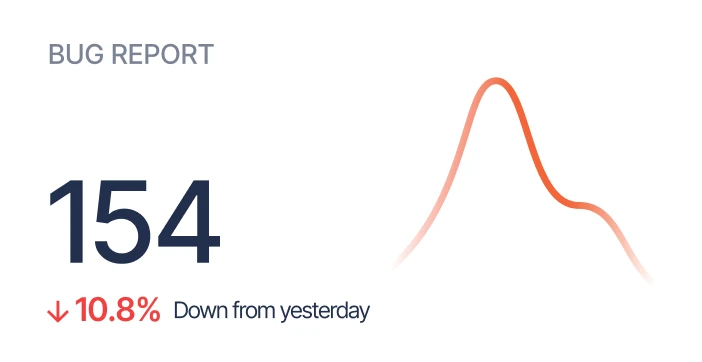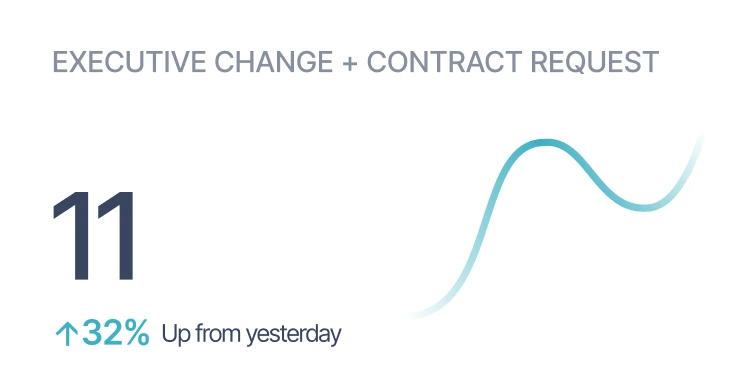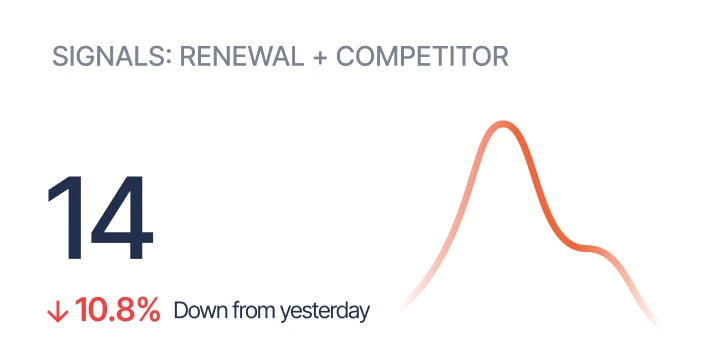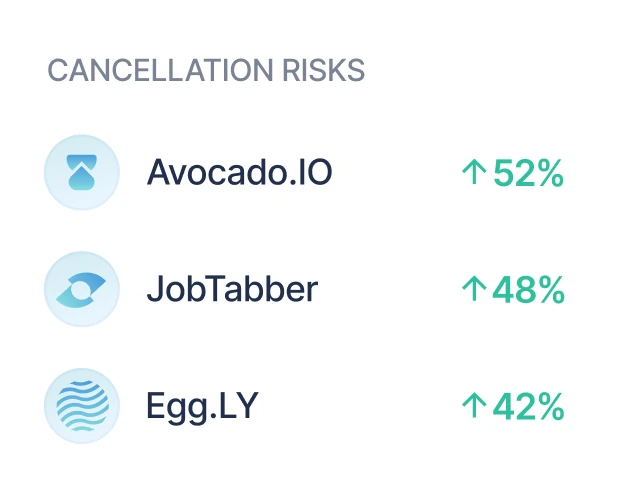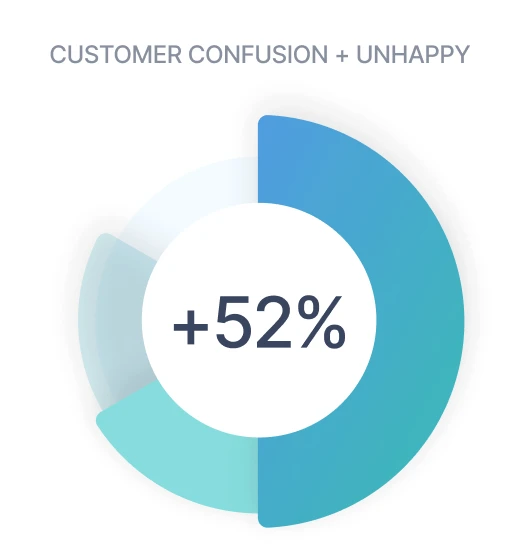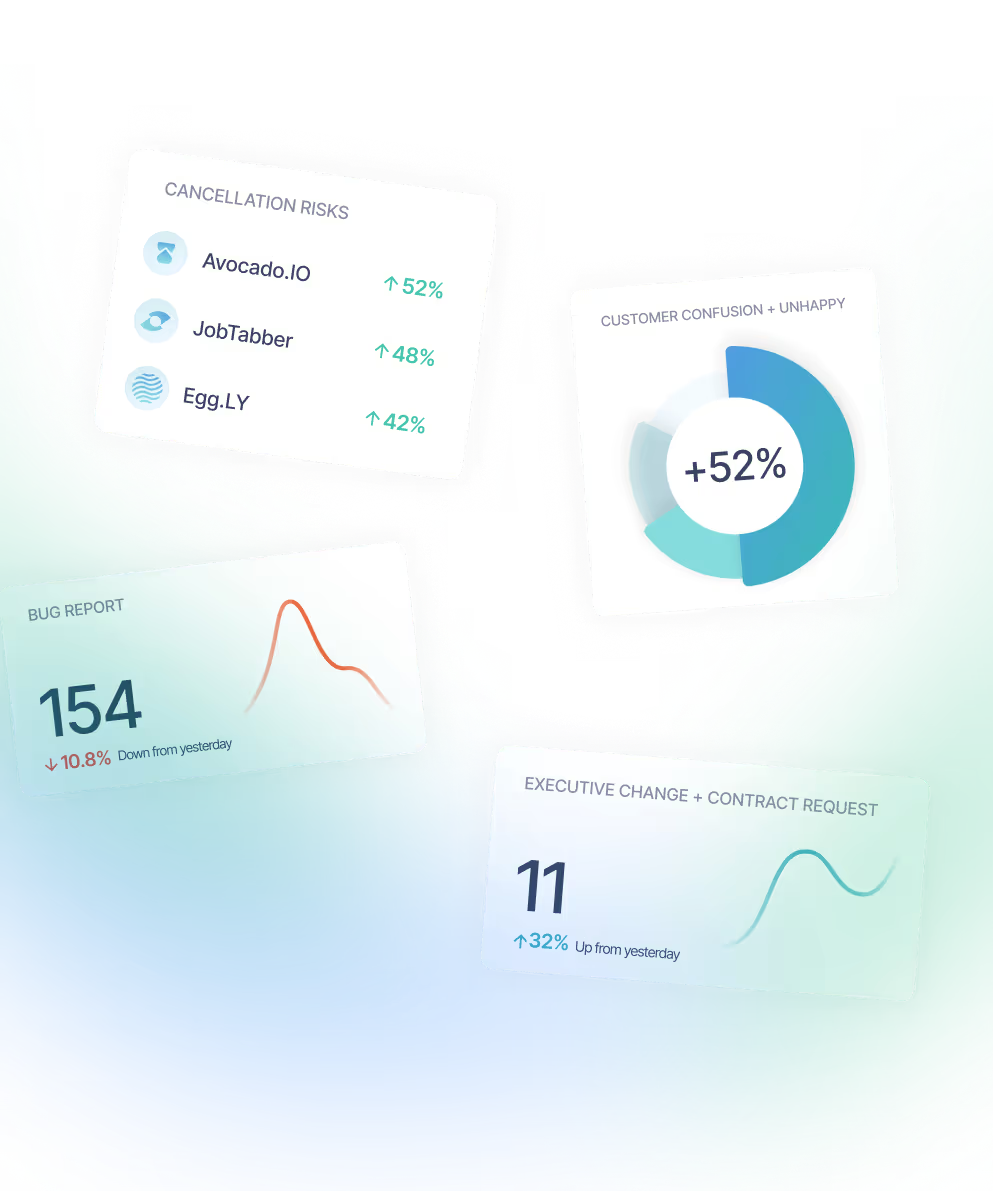
Valuize's Chief Client Officer, Emily Ryan, invited our very own Joel Passen to discuss data hiding in plain sight. Hosted on LinkedIn live, the Valuize team has been kind enough to share this excellent content with us.
Hosted by: Emily Ryan, Chief Customer Officer at Valuize
Initially hosted on LinkedIn Live
Interview Annotations
1:15 | Introduction
2:20 | Icebreaker
4:10 | When I say customer success operations, what's the first thing that comes to mind for you?
5:40 | The silo-effect
9:41 | Getting a seat at the table
11:10 | Maximize data
14:00 | The richest source of customer feedback
20:20 | Product usage data
21:21 | Telemetry data + qualitative data = insights hiding in plain sight
22:08 | Rarely are you broken up with in the moment that the breakup happens
23:32 | Taking out the guesswork
24:36 | Structuring data in a consistent and repeatable way
26:30 | We're all on the same team
0:00:08.8 S1: Hi, friends. Welcome back. I feel like it's been a million years since you’ve seen us on CS Operations. See, I don't even remember the title. A conversation with Emily Ryan. I'm Emily Ryan, and I'm so excited to have the opportunity as we have all year, this is actually coming up on a year of episodes, to have the opportunity to nerd out with some of my favorite people talking about one of my favorite topics, CS Strategy and Operations. This LinkedIn Live series aims to help define and defend investment in this critical organization, provide tips and tricks for designing a strategy to scale, and provide subject matter expertise to support this awesome new field. Each session will pose a different topic to a unique guest to help you get the most out of your time with us. If you have any questions or would like to connect with us or with each other, please feel free to engage via the comments. We'll try to leave some time to address questions during the session, but if we don't get to your question today, be on the lookout for future conversations, or you can visit our website to engage with our resources.
0:01:11.0 S1: Let's change the way people work together. I'm so excited to have Joel Passen, and I actually didn't actually ask you how you say your last name, so my apologies.
0:01:21.7 S1: Got it. You nailed it. Cool. We're good. Sweet. He is a SaaS entrepreneur, an investor, and an advisor. He is also the founder of Sturdy, a customer intelligence solution that empowers businesses to leverage unstructured customer feedback from every channel, like email, tickets, chats, meetings, and more. Sturdy uses AI and natural language processing to identify opportunities, reduce risks, and create more durable and profitable customer relationships at scale. I know durable is a huge word coming into the ecosystem right now, macro economy being what it is, but thank you, Joel, for joining me. Welcome. Thanks for having me. I'm glad to be here. Yeah, it's going to be fun. We always start with an icebreaker. Since we in the States, most states anyway, recently saw daylight savings end, it might be the last time that that happens depending on how things go in our government, but does daylight savings time mess with you? Relatedly, what is your favorite time of the day and why?
0:02:38.6 S1: I'm going to answer this in reverse, actually. Favorite time of the day is I'm a morning person. I get to work out and it's quiet in my house. Also, I think I think a little bit better in the morning. This is probably good that this event is in the morning. Morning for me, I'm on the West Coast. In terms of daylight savings messing with me, it does because I have small roommates, a six-year-old roommate and an eight-year-old roommate. They don't necessarily understand, their biological clocks don't necessarily understand daylight savings. It messes with me because it messes with them. Right. Yeah. I have furry roommates who are also like, why have not my meals appeared yet?
0:03:24.2 S2: Yeah. It's the same thing. Mine aren't that furry, but it's kind of same jam.
0:03:30.5 S1: Yeah, exactly. Yeah. I'm also a morning person, which comes in handy these days. I'm actually doing an MBA at the same time. I wake up super early to do homework, which sounds really exciting. Well, you know how to live. I mean, that's amazing. Dream life. Yeah. Learning about applied financial management this term. Go me. Awesome. Well, the second question that we always ask is when I say customer success operations, what's the first thing that comes to mind for you?
0:04:06.1 S1: I think about Rev Ops. I kind of blend all these things together. I'll tell you a quick story and the reason I mentioned this. First of all, I'll tell you, not to ingratiate you or the audience, but I think CS Ops is insanely important. I was at an event recently and somebody asked me a question like, if you're going to hire, you had $3 million in ARR and you had to assemble your team and turn in your budget. We were talking about budgeting. I'm like, what would be your, how would you backtrack the math? And I'm like, okay, first, first, good. You're talking about math. Math is good. And Ops sort of plays into that. And what I told them is I'm like, okay, I would try to figure out some sort of tech touch. Obviously I would have my head count resources. I'd be planning for some attrition in that. But I would talk a lot about in my budget, adding a CS operations or data analyst. And I would also, I think enablement CS enablement is also really, really important. And I think those are often overlooked as early hires. CS Ops, it's important to me.
0:05:16.3 S2: I would hire that person really early in my life cycle.
0:05:19.7 S1: Yeah. And, and to your rev ops point, right? I mean, we, we see sales ops come into play pretty early. We see marketing ops come into play reasonably early to get that scale, to get those touch points. But yeah, to your point, CS ops is just forgotten for a really long time.
0:05:39.7 S1: I also think that there's a little bit of the silo effect too. I mean, you know, we're, we're talking about, we're talking about data that can impact, you know, CX CS and, you know, other folks, we're talking about customer generated data, right? And, and, and the topic of this, and I think it's really important to think about like, you can hire CS ops people. I would really want them tightly aligned to the rev ops org and the business or, you know, the business systems org. I think there are more and more product operations people coming up, but all of this layer needs to sort of funnel into a consistency. And I think that's one of the big opportunities that the industry has. And I think that CS ops people sometimes are on their own Island. And I don't necessarily think that's good because the data that they play with and the data that they're making sense out of can be used by all these other teams and the teams that are using, you know, conversely, like the rev ops and product ops, most people all need to use the same data sets to create new analytical frameworks.
0:06:42.4 S2: So I'd like to see them less siloed. So I might say rev ops would be the first thing I think about because I think it's all kind of revenue operations. I think the next thing I'd say is like, keep them off their Island or out of a cave and put them more in the mainstream.
0:06:57.5 S1: Yeah. Yeah. That's interesting. I don't know if it's an Island or a cave. I feel like, I feel like it might be an Island and it's like just far enough away that you can see other people. You can't actually talk to them. Yeah. They're kind of like, what does that person on that Island do over there? Oh, that's CS ops. I'm like, that's their little, why don't they have a lot of, there's not a lot of area on their Island.
0:07:18.5 S1: You know, we need to also give them a nicer things. I think one of the things that I find in CS ops and you talk to them and these folks, these professionals, it's like, you know, how do you beg, but you know, what do you, how do you get resources? You know, do you have access to Tableau? Are you working or Domo or whatever you're using? And like, how do you, and they're kind of siloed. They're like, Oh, well I'm in our CSP and our CRM. Right. You're like, well, what, there's a broader subset of tools that in tooling that you should have. Well, we don't have the resources for that. Right. And it's the same thing by the way, in HR ops, I come out of the HR tech space, you hear it all the time, like TA ops, HR ops. They're kind of on their own little iceberg Islands in an orbit too. And they kind of look, their islands look and feel like the CS ops islands. Right. Yeah. Just like a person. And sometimes even part of a person.
0:08:10.4 S2: Yeah. Yeah. They've got one or, and they're kind of like trying to find food.
0:08:13.9 S1: Yeah. I, well, and the having nice things too. I think that that's, you know, that's one thing that, that we've spoken about a number of times on the Valuize side is as a CS operations person, learning how to speak in money because the value that you bring to your organization, if you can highlight that in real revenue and profitability terms, now folks are listening, but I think that it's taken a while for, for operations professionals to really get in that head space. Yeah.
0:08:47.5 S1: I would, I would actually add to that and say, as a, maybe, you know, I've been sort of listening at, on the conference circuit for two years and attending stuff like this and like kind of showing up in the conversation and just to listen and absorb and learn more and more. I've been more of a CRO person. I've owned CS twice. And I've always had really been fortunate to have good chief customer officer, VP of CS, CX. I've always had customer operations by the way, early on operations really important. But to your point, like I think one of the things that I've heard a lot of on the circuit to, I think a greater extent, I heard it again this year, it was like, Oh, getting a seat at the table. And there was like, there's all this kind of like talk about getting to see the table. By the way, I've heard all of this in the HR Tech years and years ago, like how does HR get a seat at the table? I'm like, it's our most important asset to have our employees first. And you're like, yeah, it's really interesting how aligned these spaces are because HR talks about the employees getting, you know, if you talk to a CEO, like, and say, what's your most important asset?
0:09:53.6 S2: They're like, Oh, our people. Right. And behind closed doors, they might say our cap structure, right. And I think in customer success, by the way, they're like, we want to see to the table and you go to the CEO, like what's your most important constituencies of people? And of course our employees and our customers, you know, they're equal. But yet I think one of the things that people forget about is thats lip service to a certain extent. And that if you want to see to the table, you got to talk in revenue speak because CROs and the product people, you know, the product people kind of get a pass to no fault of their own. They get, they get nice things. Sales teams get nice things because they own a huge number and somebody thinks they need nice things to make that number. But I think that's trend. We might be moving the needle for CS folks, but I think I really encourage people to think about like, yeah, when you speak in revenue, you wield power. That gets you a seat at the table immediately.
0:10:49.2 S1: Exactly. Exactly. Yeah. So digging into like how, right? So, I mean, early in my software career, I had the opportunity to dive into customer success operations even before it really formally existed as such. And one of the first things I learned in that experience was to maximize data, to gain any level of consistency against delivery. Today, over a decade later, we still come across clients at Valuize who insist that they don't have data. And usually it's because they're focused on like product telemetry specifically, but I know Sturdy aims to debunk this myth by leaning into the rich data sets that commonly go unnoticed and aren't tapped into. What are your thoughts about how companies really, especially B2B, but you can talk about any company, can lean into that rich vein of data and what is this data and why is it important?
0:11:52.7 S1: Well, I think it'd start with a stat. So we've had the really good fortune at Sturdy to analyze 55 million conversations collectively. And these can be things from call transcripts to tickets to in-app chats to customer email. And so when companies, to your point, when they talk about, oh, we just don't have any data or our data is a mess because you hear those two things in, oh, not quite ready for that because our data is a mess. And my answer to them is the first thing is I'm like, you have an enormous, enormous amount of language, like your language and feedback, and it's all stuck in email in a variety of silos. And so you have the data and you've been collecting the data for a very long time. And there's trends in that data. If you just think about the single channel in email, it's amazing. And yes, it is an enormous rat's nest of unstructured data. But the cool thing is there are companies and Sturdy is not the only one. There are others that are starting to make sense out of that and being able to distill that information from these silos, ingest it and restructure it in a very consistent, accurate way.
0:13:01.2 S1: So the, we don't have any data is a tough one these days because you just have a ton of ticketing data. I mean, the backend of your Gong calls or your Zoom calls with your customers, enormously valuable data. So it might not be what you would think of your data, Emily, in the traditional sense, like how many emails have we sent? How many times have we engaged the customer, which is really important stuff, but we all, you know, that's the kind of stuff we probably should have, but that's all telemetry based numbers that we look at in our rears. So, yeah, there's by the way, you know how many, you know, I'll put you on the spot here. You might know the answer to this. I feel like I've switched the thing you're supposed to. It's a dialogue we can talk.
0:13:46.7 S2: Okay, cool. If you don't, I have the answer. So if you don't want the answer, how many, so across B2B SaaS companies, $50 million in revenue or higher, how much do you think in terms of all the channels of communication with customers these days, minus in person, because that's impossible to track unless the calls are recorded. What do you think the richest source of feedback and customer feedback or insights is derived from what channel of communication?
0:14:13.8 S1: Like where is it derived from today? Yeah.
0:14:17.0 S2: Like what, where does the, where does the potential lie? What is the, what, where do you think the treasure trove is?
0:14:23.1 S1: Gotcha. I would say it's just all of the back and forth engagement. So anytime your customer responds to something or reaches out, so I'm going to cheat and say any inbound email from your customer and more specifically support tickets.
0:14:45.2 S2: Yeah. You're right. What we find is over 60% of the back and forth communication between customers and I'm talking users and customers, not just your key stakeholders, over 60% of it is an email across on an average nine inboxes. Yep. So if you think about it, yeah, we don't have the data. You can't say you don't have that. You have a lot of data just unfortunately stuck in all these little pits, these little tar pits that you can't get things out of, you know, conveniently. But there's a lot of really, you know, customers in an, you know, if you look at emails and you analyze emails, it's really like an unabridged, unbiased voice of the customer. They are telling you the answers. Yes. It's just really hard to get at.
0:15:27.9 S1: Right. Well, and to your point, like the nine, I mean, there are nine silos into which those emails dump and there's overlap with different emails. So let me see. I would imagine that's, probably some of that goes directly to your sales person because there's never been a severed relationship there. Not that that relationship should be severed, but it should be re refocused. Right. It's your, whoever your technical kind of onboarding first person that talks to your customers inbox or group inbox, it's your CSM or CSM equivalent. So if you have a pool model or digital model, it's your support, ecosystem. So all of the tickets and all of the rich things there, I would imagine it's any engagement with your community or your marketing, ecosystem. Let's see, that's, that's half.
0:16:23.3 S2: I'll give you, you're, you're an expert, so you're, but hold on, hold on. Yeah. Billing. Oh yes. So when you, when you build accounting, accounting is huge and it's, by the way, it's very literal. Those are very binary exchanges.
0:16:38.2 S1: Can I have a copy of our contract?
0:16:39.7 S1: When is the renewal of our contract? Yes. It's, it's November 15th. When's our auto renew trigger. Right. So, and possibly if you've got, you know, similar like that, linking that information with a support ticket, I'm cheating cause you told me this, but I'm linking that information with a support ticket that says, can you point me to the place where I can extract data from our system? Now you've got turn. Yeah. Well, you've got a couple of different vectors to say like, Hey, this is an issue. By the way, if you get a support ticket, it's kind of interesting for like when is our renewal date and somebody might go into Salesforce and be like, and by the way, in, in trying to do the right thing, you know, in a timely manner to provide an excellent level of service. Hey Emily, it's November 15th. Thank you so much. Is there anything I can help you with? No, there's not. Emily Ryan says, okay, case shut right. I'm moving on. If you blend all that language together or if those things get, escalated to somebody that's like, hold on a second, let's have a conversation with these people.
0:17:42.0 S1: They're asking a question that, you know, 65% of the time leads to a cancellation in the next 12 months. Right. So we need to get this to somebody that has the aptitude, you know, probably an account manager or a CS person that can have a conversation with these people and better understand why they're asking the question. Can you save a couple of customers a year doing that? Yeah. That's using data hiding in plain sight to actually lift net retention or you're just kind of stem this, you know, stem off cancellations. Right. I mean, that's what we're talking about when we're using qualitative data to do this stuff. It's the, they're there, the, the signs, the insights are sitting on there. The other ones, by the way, so billing program management, people that are touching integrations or partnership types things where you're engaging or, you know, maybe you're upset, maybe you're getting upsold by account management. So, anywhere from like seven to 12, right. Seven to twelve touch points at any given time at larger enterprises. It's, it's vast, even bigger, could be marketing, could be advocacy groups, that actually get insights from customers where they're like, I can't give you a customer testimonial right now.
0:18:47.6 S1: We'd love to, but we have this issue. So what does a customer marketing person do? Like they try to solve that. Do they escalate it? Do they have to do data entry somewhere? I mean, there's some really murky things that happen to even with people that are well-trained and have the best interests. Exactly. Exactly. Well, and you know, this is another reason why we, we try to help our, our clients with, with whatever system they have starting to make sure that you are viewing the customer with the same lens. We see a lot of folks silo internally, the customer's information and data set by internal team members. So my CSM has of you, my salesperson has of you, my technical account manager has of you and the views are slightly different. And so one of the things that we do is try to crack that open and even extend it. So not only is your whole post-sale customer team looking at the same set of customer information, but we're making sure that support has a view into that, that professional services has a view into that, et cetera. and it's, this is the same type of motion.
0:19:53.9 S1: It's like these, not just the customer information, but the data around all of those interactions. And to your earlier point, it's not, it's not just about quantitative interactions. How many times or, you know, how many times did my customer user open or click on like that's important data probably, but then what, so what, what else happened?
0:20:20.9 S1: I also think that product usage data, if you're in like the, we have payroll providers as customers, you don't just stop doing payroll or tail off and doing payroll in January 1st when your first payroll starts with your new customer. Yeah. Your usage goes from like a hundred percent to nothing that usage doesn't tell that story. So some of the things that we incorporate, I know that, Valuize does good work with customers around helping them sort of create, maybe more holistic health scoring. And I read a lot, you know, like part of the reason that I think I'm on this, with you today is like, you talked about data centricity and I was like, yeah, that's the, that's the, you know, and some of the value wise content, which I think is really quality. And I've mentioned this to your team before, really quality content for people that are looking to get information. You guys write a bunch of, but data centricity, which isn't a light reading topic, but it's really, really important. So, I mean, I think that's what you're trying to get at without beating your own drum, but it's really, really important.
0:21:21.4 S2: So yes, telemetry data combined with qualitative data is sort of like, if you take the data that's been hiding in plain sight, the stuff that you're collecting, you have reams up, you just need to make actionable and you combine it with some of this telemetry based data. It accelerates or, or, I think enhances the story. Like you kind of get to the, what we're all looking for is like, this is happening. Oh my gosh. Like, and then you have to say why, and someone can be like, this is what we've seen. This is a lot of the topics in their conversations go around these feature requests. And one of the things we talk a lot about is like cancellations. They don't happen in a vacuum. No, it is a compilation of lots of things with all of these different actors in all these different silos. And this is part of the reason that's really hard to get in front of cancellations. It's like it's all over the place and it's death by a thousand cuts.
0:22:08.5 S1: Yep. Yep. And just like any, any relationship, you know, rarely are you broken up with in the moment that the breakup happens, you've been broken up with mentally long ago, right? Yeah. Well, yeah, yes. And you know what we're talking about, we're talking about investing in relationships. So, I mean, that metaphor goes a really long way. And when I, I mean, I'm sure you get out and talk to your customers. I get out and talk to mine. It's like, yeah. I mean, think about your own relationships. There are fractures and fissures. And by the way, sometimes, and to this point, sometimes you have really hard conversations in a relationship, a personal relationship, and it makes you stronger with that person because you get to trust. And I think that confronting these fissures and fractures and client relationships head on and honestly with, with high intellectual honesty, right. Sometimes can create a really strong partnership with that customer. They're going to renewal infinitely, right? They love you. You've provided value. Listen to them and listening to their customers, like kind of how this all starts, because that's kind of key to a relationship. So absolutely. And you know, your, your, the work that you're, you and your team are doing helps enlighten your internal teams broadly about those things that your customer is telling you, right?
0:23:26.3 S1: So you can have, it's, it takes the bias out of things or the guesswork like, Hey Emily, how is a XYZ customer?
0:23:32.6 S1: Are they green, yellow or red? Well, I think, I feel like, I feel like that's how a lot of these conversations start where I'd like to say, I feel like they're a little bit of a yellow because we don't have this particular feature and the buyer, we lost our executive sponsor and the new executive sponsor has bought ADP or workday or whatever the competing product is before. So I think we have a little bit of risk. That's what I know. Now, if I'm a leader and I get that download and I'm like, okay, we need to fly to Topeka and go talk to these people and go, that's a trip that I'm going to budget. Like we need to get in front of these. What's their error? Oh, it's this. Yeah. We should get in front of those folks. Right. Yep. No, it's true. And I think, you know, one of the things that we were talking about the other day was just the kind of, you know, we talked about rev ops, the sales and marketing components of that really have learned how to get a lot of data and structure that data in a really consistent, repeatable way.
0:24:36.2 S1: And customer success and post sales in general seem to continue to lag behind when it comes to truly understanding customers through data. Just as kind of our final moment here, what's your perspective when it comes to this like dichotomy within SaaS businesses and how can companies strive to overcome that?
0:24:58.8 S1: So the first thing that I would say just with few words is that it's a maturity issue. You know, CS ops is relatively new compared to revenue operations, which is I think fairly stable. I mean, any business with over, I don't know, what do you think? I'm like $5 million in ARR? You're going to have a full-time rev ops person or at least somebody who's aspiring to do that role, if not augmented with some sort of consulting, cause you're going to need it. And as the motions grow, it just gets more, you know, those teams bloom. There's a whole industry around it. There are platforms, all kinds of stuff. It's mature. I think in CS it's just not mature. And I think the second point is, you know, how do we get people there? I think that like anything else, like how, how does a good sales person or account manager learn? They learn through osmosis through shadowing and being mentored by someone else. So I think CS ops and it comes full circle. Like you asked me what I think of CS ops. I'm like rev ops because I want my CS people, my CS team to be lockstep with the revenue motions with rev ops so that we have to pair them together and that'll increase the maturity on our mathy and data side of the world in customer success or post sales motions.
0:26:10.9 S2: Yeah.
0:26:11.4 S1: Yeah.
0:26:11.7 S1: Like we have to, we have to get closer by the way. They're too, these teams are too segmented. They're too segmented. Like we're all in the revenue game and we're all in the delighting the customer game, whether it's product sales and customer success, we are all on the same team. And that I think sometimes is lost in fiefdom building. It really is. Yeah. Yep. That's a, that's a, that's a nice little tagline into, I will, I will shamelessly pitch our value experience framework release drives to break down those silos and help teams work together towards a common discipline so that, so that we're really driving towards net dollar retention and delight is a core part of that.
0:26:53.4 S1: Well, let me know if you guys take the show on the road to Topeka. I'm available. They have planes. Sounds good. Sounds good. I feel like it's starting to get to the wrong season to be in Topeka, but It is actually, I've never been to Topeka this time of year, but I would imagine that we probably want to wait until the spring.
0:27:11.4 S2: No offense to Topeka constituents, but yeah. Yeah.
0:27:14.6 S2: I know that, you know, Kansas is a, is a neighbor of ours and man, do they get the weather that just comes right off, but skips Denver and then just goes straight to Kansas. So it's wait until spring. Well, as usual, this time just completely flew. Thank you, Joel. And thank you everyone for joining the discussion today to uncover data in your blind spots and maximize customer insights. Let's change the way people work together. Let's do this again too. Let's do it again.
0:27:49.5 S1: Right. Let's, we have so much to talk about. We can keep talking later. Thank you. Thanks for having me. My pleasure.

.png)

.png)
.png)


